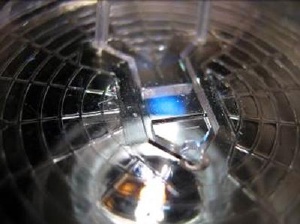Feb 21 2009
Researchers at Uppsala University have developed a new tool that makes it possible to study the signals in the body that control the generation of blood vessels. The researchers' findings, published in the new issue of Lab on a Chip, enable scientists to determine what signals in the body attract or repel blood vessels, knowledge that is extremely interesting in tumor research.
 A tiny cell cultivation chamber of silicon plastic in which researchers can cultivate blood-vessel-rich tissue and simultaneously create targeted signals that instruct the vessels to go in a certain direction. Credit: Photo: Sara Thorslund
A tiny cell cultivation chamber of silicon plastic in which researchers can cultivate blood-vessel-rich tissue and simultaneously create targeted signals that instruct the vessels to go in a certain direction. Credit: Photo: Sara Thorslund
The new invention is a tiny cell cultivation chamber of silicon plastic in which researchers can cultivate blood-vessel-rich tissue and simultaneously create targeted signals that instruct the vessels to go in a certain direction. This is of great interest to the international research world.
Angiogenesis is the process in the body that forms new blood cells, a process that is vital for life but can also be fatal in the worst case. Angiogenesis is desirable, for instance, in connection with wound healing, when new tissue needs to be grown. Undesirable angiogenesis, on the other hand, often occurs in connection with tumor growth. Through the newly generated blood vessels in the vicinity of the tumor, tumor cells receive nourishment and oxygen, which creates the conditions for tumor growth. One way to limit tumor growth may therefore be to counteract the new formation of blood vessels in the tumor, thereby cutting off the supply of nourishment and oxygen to the diseased area.
The scientists Irmeli Berkefors and Johan Kreuger's research is geared toward understanding the signals that control both normal and pathological angiogenesis. To understand this, it is important to construct experimental model systems in which they can study how concentration gradients of various signal proteins affect the direction in which a vessel grows.
"Our new method enables us to recreate and study gradients that control how blood vessels grow in the body. This is something of a research breakthrough. Now we can systematically evaluate newly identified signals that we hope can ultimately be used to control angiogenesis," says Johan Kreuger.
The method can also be used to unearth new knowledge regarding how tumor cells and nerve cells grow and move toward gradients of signal proteins.